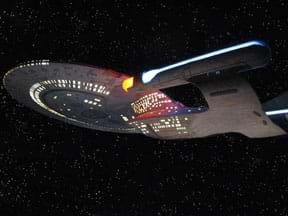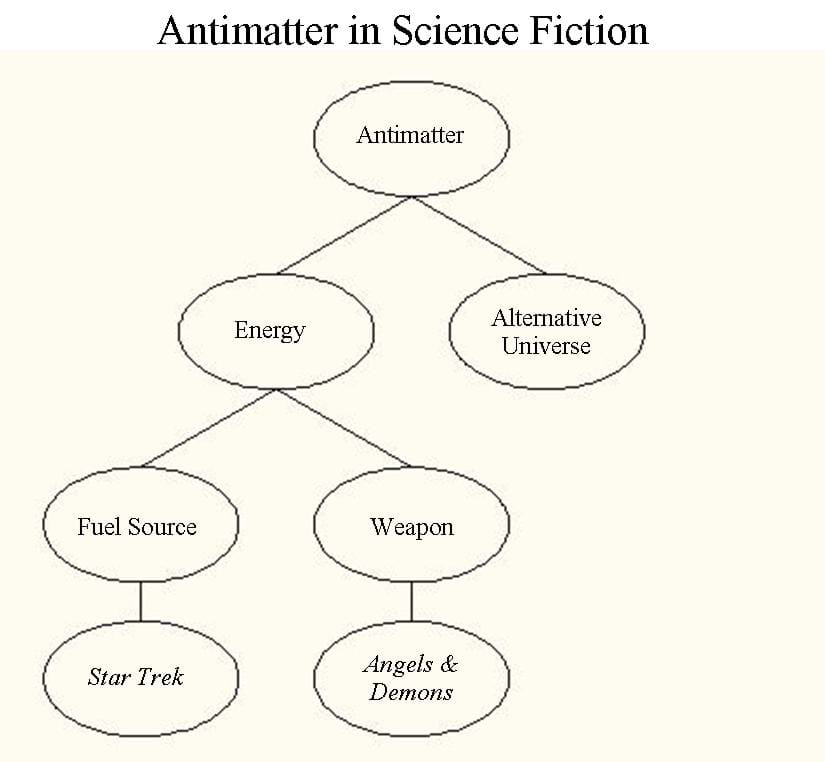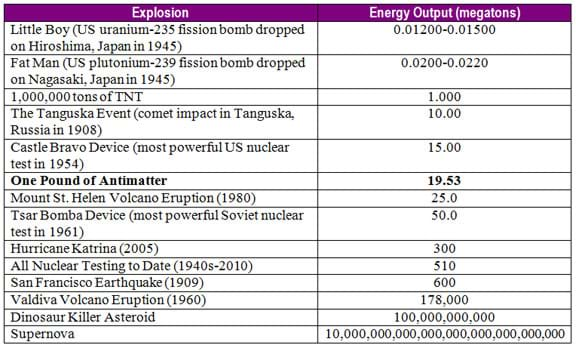Quick Look
Grade Level: 6 (6-9)
Time Required: 30 minutes
Lesson Dependency: None
Subject Areas: Physical Science

Summary
Antimatter, the charge reversed equivalent of matter, has captured the imaginations of science fiction fans for years as a perfectly efficient form of energy. While normal matter consists of atoms with negatively charged electrons orbiting positively charged nuclei, antimatter consists of positively charged positrons orbiting negatively charged anti-nuclei. When antimatter and matter meet, both substances are annihilated, creating massive amounts of energy. Instances in which antimatter is portrayed in science fiction stories (such as Star Trek) are examined, including their purposes (fuel source, weapons, alternate universes) and properties. Students use the associated activity to compare and contrast matter and antimatter, learn how antimatter can be used as a form of energy, and consider potential engineering applications for antimatter.Engineering Connection
Scientists and engineers around the world are currently developing antimatter in laboratories. Antimatter is currently the most expensive resource on Earth at $62.5 trillion dollars per gram. However, if antimatter could be produced efficiently in laboratories or harvested from space, it would provide the most efficient energy source available. An antimatter rocket would revolutionize aerospace engineering and space travel because the energy packed into antimatter is about a billion times greater than the energy in ordinary rocket fuel. Antimatter could also provide a clean energy source on Earth. This would likely form a new type of engineering that would focus on antimatter much in the same way that petroleum and nuclear engineers function in today's society.
Learning Objectives
After this lesson, students should be able to:
- Compare and contrast matter and antimatter.
- Explain how antimatter can be used as a form of energy.
- Describe engineering applications for antimatter.
Educational Standards
Each TeachEngineering lesson or activity is correlated to one or more K-12 science,
technology, engineering or math (STEM) educational standards.
All 100,000+ K-12 STEM standards covered in TeachEngineering are collected, maintained and packaged by the Achievement Standards Network (ASN),
a project of D2L (www.achievementstandards.org).
In the ASN, standards are hierarchically structured: first by source; e.g., by state; within source by type; e.g., science or mathematics;
within type by subtype, then by grade, etc.
Each TeachEngineering lesson or activity is correlated to one or more K-12 science, technology, engineering or math (STEM) educational standards.
All 100,000+ K-12 STEM standards covered in TeachEngineering are collected, maintained and packaged by the Achievement Standards Network (ASN), a project of D2L (www.achievementstandards.org).
In the ASN, standards are hierarchically structured: first by source; e.g., by state; within source by type; e.g., science or mathematics; within type by subtype, then by grade, etc.
Common Core State Standards - Math
-
Use ratio reasoning to convert measurement units; manipulate and transform units appropriately when multiplying or dividing quantities.
(Grade
6)
More Details
Do you agree with this alignment?
-
Fluently divide multi-digit numbers using the standard algorithm.
(Grade
6)
More Details
Do you agree with this alignment?
-
Fluently add, subtract, multiply, and divide multi-digit decimals using the standard algorithm for each operation.
(Grade
6)
More Details
Do you agree with this alignment?
-
Perform operations with numbers expressed in scientific notation, including problems where both decimal and scientific notation are used. Use scientific notation and choose units of appropriate size for measurements of very large or very small quantities (e.g., use millimeters per year for seafloor spreading). Interpret scientific notation that has been generated by technology.
(Grade
8)
More Details
Do you agree with this alignment?
International Technology and Engineering Educators Association - Technology
-
Analyze how the creation and use of technologies consumes renewable and non-renewable resources and creates waste.
(Grades
6 -
8)
More Details
Do you agree with this alignment?
State Standards
Texas - Science
-
Scientific investigation and reasoning. The student knows how to use a variety of tools and safety equipment to conduct science inquiry. The student is expected to:
(Grades
6 -
8)
More Details
Do you agree with this alignment?
-
Matter and energy. The student knows that interactions occur between matter and energy. The student is expected to:
(Grade
7)
More Details
Do you agree with this alignment?
-
Matter and energy. The student knows that matter is composed of atoms and has chemical and physical properties. The student is expected to:
(Grade
8)
More Details
Do you agree with this alignment?
-
Science concepts. The student knows that relationships exist between the structure and properties of matter. The student is expected to:
(Grades
9 -
10)
More Details
Do you agree with this alignment?
-
Scientific processes. The student uses a systematic approach to answer scientific laboratory and field investigative questions. The student is expected to:
(Grades
9 -
12)
More Details
Do you agree with this alignment?
-
design and implement investigative procedures, including making observations, asking well-defined questions, formulating testable hypotheses, identifying variables, selecting appropriate equipment and technology, and evaluating numerical answers for reasonableness;
(Grades
9 -
12)
More Details
Do you agree with this alignment?
Pre-Req Knowledge
A basic knowledge of matter and atoms.
Introduction/Motivation
(Begin by asking the class questions to assess their understanding.)
What is matter? Raise your hand if you have heard of something called antimatter. What is antimatter?
(Show a video clip from Star Trek: The Original Series, episode 27, "The Alternative Factor." In the clip, Kirk and Spock hypothesize that there is a Lazarus and anti-Lazarus and explain the concept of antimatter. They realize that if both the Lazarus and anti-Lazarus meet, the result would be total annihilation.)
After watching the video clip, what did you learn about antimatter? What happens when matter and antimatter meet? Do any of you know what energy source the engines of the USS Enterprise, the starship in Star Trek, use? (The engines are powered by antimatter.)
(Draw Figure 1 on the classroom board while describing some of the occurances of antimatter in science fiction.)
Antimatter is a common concept found in many works of science fiction, including Star Trek. You probably know more about antimatter and alternative universes than you realize because of they are woven into the stories of popular movies. In science fiction tales, antimatter is usually mentioned as it relates to two topics: energy or alternative universes. Further, when antimatter is portrayed as an energy source, it is commonly either a fuel source or a weapon. Can you think of some things we could use antimatter to power? (Example answers: To make electricity, power rockets, etc.) Can you think of an example of this in a science fiction scenario? (In Star Trek, the engines of the USS Enterprise are powered by antimatter.) Can you think of a science fiction example in which antimatter was used as a weapon? (An example is in the Angels & Demons book/movie.)

(Draw Figure 2 on the board while explaining alternative universes portrayed in science fiction.)
In science fiction, we see three types of alternative universes portrayed. The first is charge-reversed, or C-reversed. Since antimatter is charge-reversed matter, a C-reversed universe would be comprised entirely of antimatter; however, it would otherwise be indistinguishable from a universe made of matter because chemistry and anti-chemistry follow the same rules. Can you think of an example from science fiction of a C-reversed universe? (The Star Teck clip described a C-reversed universe.)
The second type of alternative universe often encountered in science fiction is parity-reversed or P-reversed. It is also referred to as a Looking Glass universe because everything in the universe is left/right reversed. For example, a person's heart would be located on the right side of his or her body. Can you think of an example of a P-reversed universe? (The sequel to Alice in Wonderland, Through the Looking Glass, includes an example of a P-reversed universe.)
The third type is time-reversed or T-reversed. In a T-reversed universe, a person would grow younger instead of older. Can you think of an example of this? (The Curious Case of Benjamin Button has elements of a T-reversed universe.)

Now that you are familiar with antimatter and how it is portrayed in science fiction, let's talk about how everything we just put on the board relates to the real world. (Continue the lesson by providing students with suitable content from the Lesson Background section.)
Lesson Background and Concepts for Teachers
The Beginnings of Antimatter
In 1928, British physicist Paul Dirac predicted the existence of antimatter when he mathematically proved that Einstein's famous equation of relativity should actually read E = ±mc2 . This implied the existence of anti-electrons (positrons). American physicist Carl Anderson discovered the positron in 1932, and Dirac won the Nobel Prize in 1933 for the discovery of antimatter.
Antimatter and the Big Bang
Our universe is comprised almost entirely of matter, which is puzzling to scientists. Andrei Sakharov, designer of the Soviet Union's hydrogen bomb, proposed the most likely reason. Sakharov theorized that in the beginning, there was slightly more matter than antimatter in the big bang. This asymmetry is referred to as CP violation and relates to C- and P-reversed universes. The theory states that everything in our current universe is made from the slight excess of matter present in the big bang.
Antimatter and Alternative Universes
Einstein and Dirac's equations are still valid when both charges and left/right are reversed. This led scientists to believe that a CP-reversed universe could exist - until the 1960s. In 1964, a CP-reversed system was proven to defy the laws of physics. This was a good thing, because it resulted in the CP violation that allows matter to be present in our universe. However, it is still mathematically possible for a CPT-reversed universe to exist.
Antimatter Production
Antimatter has been produced in laboratories around the world in very small amounts since 1955. However, storing it is difficult because of its volatile nature. It is also the most expensive substance on Earth at 62.5 trillion dollars per gram.
Antimatter Applications
Antimatter is the most efficient energy source on Earth. If one combined one kilogram of antimatter with one kilogram of matter, the resulting energy release would be roughly equivalent to 43 megatons of TNT. If antimatter could be produced more quickly and economically, it would enable aerospace engineers to revolutionize space travel allowing interplanetary travel or possibly interstellar travel. Aerospace engineers are specialized engineers who design aircraft and spacecraft. Another application would be to use antimatter energy to produce electricity for humans' daily needs (Refer to the Presentation Skills to Win that Bid! Selling Your Power Solution activity to have students compare different resources and to craft a solution to satisfy energy needs). A new type of engineering would likely emerge, similar to the current fields of nuclear and petroleum engineering, which specialize in designing ways to harness nuclear and petroleum based energy, respectively.
Associated Activities
- Presentation Skills to Win that Bid! Selling Your Power Solution - Students determine what type energy to use for a new power generation plant. The activity is written to have students consider conventional sources of power, but you could include antimatter as one source that students explore, to make it a good follow-up activity to this antimatter lesson.
Vocabulary/Definitions
antimatter: Matter whose parts match parts of ordinary matter except in having some opposite properties (as a positive instead of a negative charge).
charge-reversed universe: Universe where positive and negative charges are reversed.
parity-reversed universe: Universe where left and right are reversed.
time-reversed universe: Universe where time runs backwards.
Assessment
Pre-Lesson Assessment
Question/Answer: Ask students questions to find out what they know about antimatter.
Lesson Summary Assessment
Drawing/Writing: Have students draw pictures of antimatter rockets and write paragraphs describing how antimatter is used to provide rocket fuel. Have students answer the following questions:
- What is matter?
- What is antimatter?
- How are matter and antimatter the same?
- How are matter and antimatter different?
- What happens when matter and antimatter touch?
- Describe how antimatter can be used as a form of energy.
- How can engineers use antimatter?
- Why is antimatter a clean energy source?
- What are some examples of things that antimatter could be used to power?
Lesson Extension Activities
Calculate the Amount of Antimatter Needed to Power a House for One Year
Challenge students to calculate the amount of antimatter needed to power a house for one year. The conversion uses Einstein's famous equation, E = ±mc2 .
Determine the Energy Needed
First, an assumption needs to be made concerning the average number of watts used in a household per day. For this case, let's assume that on average, this household uses 600 watts.
600 watts x 24 hours/day = 14,400 watt-hours/day = 14.40 kilowatt-hours/day
14.40 kilowatt-hours/day x 365 days/year = 5256 kilowatt-hours/year
1 kilowatt-hours = 3.6 megajoules
5256 kilowatt-hours/year x 3.6 megajoules/kilowatt-hours = 18,900 megajoules/year
= 18.9 x 1010 joules/year
The Speed of Light
The speed of light is approximately 300,000,000 m/s2.
Einstein's Equation
E = mc2
m = E/c 2
m = (18.9x1010 joules/year) / (300,000 m/s)2
m=2.10 x 10-7 kg/year
Antimatter/Matter Annihilation
We need equal amounts of matter and antimatter to annihilate one another and create energy. Therefore, the amount of antimatter is half of the mass, which is 1.050 x 10-7 kg/year.
Convert from Metric to English Units
Convert from kilograms (a metric mass unit) to pounds (an English force unit) so students have a better understanding of the magnitude of the material. Note: This conversion assumes that gravity is 9.81 m/s2.
1.050 x 10-7 kg x 35.3 ounces/kg = 3.71 x 10-6 ounces/year
1 pound = 16 ounces
3 .71 x 10-6 ounces / 16 ounces/pound = 2.32 x 10-7 pounds/year
Determine the Size of an Explosion that One Pound of Antimatter would Create
Since the amount of antimatter required to power a house for one year is so small that it is not easily understandable, the same calculations can be completed in reverse order to determine the size of explosion one pound of antimatter could create. Then, compare this explosion size to well-known explosions in history.
Convert from English to Metric Units
We need to convert from pounds (an English force unit) to kilograms (a metric mass unit).
1 pound = 16 ounces
16 ounces x 0.0283 kg/ounce = 0.4535 kg
Note: This conversion assumes that gravity is 9.81 m/s2.
Antimatter/Matter Annihilation
We need equal amounts of matter and antimatter to annihilate one another and create energy. mass = m = 2 x 0.4535 kg = 0.907 kg
The Speed of Light
The speed of light is approximately 300,000,000 m/s2.
Einstein's Equation
E = mc2
E = 0.907 kg x (300,000,000 m/s2)2 = 8.16 x 1016 joules
1 megaton = 4.18 x 1015 joules
8.16 x 1016 joules / 4.18 x 1015 joules/megaton = 19.53 megatons
Compare to Famous Explosions in History

Additional Multimedia Support
Star Trek: The Original Series Episode 27 "The Alternative Factor", available at https://www.tvguide.com/tvshows/star-trek/episode-27-season-1/the-alternative-factor/100408/
Equal amounts of matter and antimatter were created at the birth of the universe but very little antimatter exists today. Dr. Tara Shears explains why this is one of the greatest mysteries in science and how it might be solved by the biggest experiment in history. Watch The Matter with Antimatter video (3:09 minutes), available at YouTube: https://www.youtube.com/watch?v=8XufjtmEe5w
Subscribe
Get the inside scoop on all things TeachEngineering such as new site features, curriculum updates, video releases, and more by signing up for our newsletter!More Curriculum Like This

Students are introduced to the basic known facts about the universe, and how engineers help us explore the many mysteries of space.

Students learn about atoms and their structure (protons, electrons, neutrons) — the building blocks of matter. They see how scientific discoveries about atoms and molecules influence new technologies developed by engineers.
References
Kaku, Michaio. Physics of the Impossible. New York, NY: Anchor Books, 2008.
Copyright
© 2013 by Regents of the University of Colorado; original © 2010 University of HoustonContributors
Rachel Howser; Christine HawthorneSupporting Program
National Science Foundation GK-12 and Research Experience for Teachers (RET) Programs, University of HoustonAcknowledgements
This digital library content was developed by the University of Houston's College of Engineering under National Science Foundation GK-12 grant number DGE-0840889. However, these contents do not necessarily represent the policies of the NSF and you should not assume endorsement by the federal government.
Last modified: May 27, 2019







User Comments & Tips